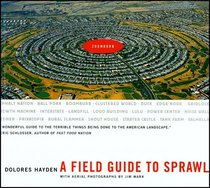Interesting aerial photos, and some help with the lingo, but otherwise the text is a bit over the top.
Foreword. I found no value in it.
Part One. Decoding American Landscapes. pp. 7-16.
This is succinct, includes quoting of leading professors in the field, and is best for students with good reading skills. When a US History class is considering HST's term in office, this would make a good collateral learning project: A very interested student(s) could read and offer the highlights to the class, with all class members choosing a different photo to share with the whole class. The book is better done than I expected when I ordered several nonfiction books (to go along with a fulfilled wish) for the old soldiers and sailors' home. I am reminded that real estate development is very much a capitalist enterprise, unlike environmental concerns and the author emphasizes that several 20th C. government programs supported such development. Professor Hayden points out that 'visible waste is part of sprawl' and can be seen in nearly empty Main Streets, junkyards, vast parking lots, etc.
The author gives a few examples of the fifty cent words used by professionals in the field and notes that she is using popular words, often coined by journalists and the like, in this book to allow a better understanding by the reader. She hopes that local residents with a better idea of what is going on will fight sprawl in favor of sustainable development.
The author than briefly discusses efficient uses of aerial photography and concludes that she has published this book to help citizens have the 'ability to critique bad building patterns that helps them visualize positive changes.'
Part Two. An Illustrated Vocabulary of Sprawl. pp. 17-119. [I might add 'man camps' used by oil workers today]
Good bibliography, sources for captions given, websites offered, and there is an index. Because there is no index of locations, I deducted one star from my evaluation.
Part One. Decoding American Landscapes. pp. 7-16.
This is succinct, includes quoting of leading professors in the field, and is best for students with good reading skills. When a US History class is considering HST's term in office, this would make a good collateral learning project: A very interested student(s) could read and offer the highlights to the class, with all class members choosing a different photo to share with the whole class. The book is better done than I expected when I ordered several nonfiction books (to go along with a fulfilled wish) for the old soldiers and sailors' home. I am reminded that real estate development is very much a capitalist enterprise, unlike environmental concerns and the author emphasizes that several 20th C. government programs supported such development. Professor Hayden points out that 'visible waste is part of sprawl' and can be seen in nearly empty Main Streets, junkyards, vast parking lots, etc.
The author gives a few examples of the fifty cent words used by professionals in the field and notes that she is using popular words, often coined by journalists and the like, in this book to allow a better understanding by the reader. She hopes that local residents with a better idea of what is going on will fight sprawl in favor of sustainable development.
The author than briefly discusses efficient uses of aerial photography and concludes that she has published this book to help citizens have the 'ability to critique bad building patterns that helps them visualize positive changes.'
Part Two. An Illustrated Vocabulary of Sprawl. pp. 17-119. [I might add 'man camps' used by oil workers today]
Good bibliography, sources for captions given, websites offered, and there is an index. Because there is no index of locations, I deducted one star from my evaluation.




